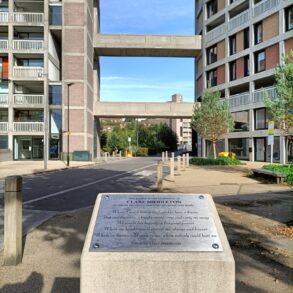When Freddy Diaz thinks of graffiti at Michigan Central Station, he thinks of childhood in Detroit and not giving up.
He’s not alone.
This is why the multimillion-dollar restoration of the 1913 historic depot includes spray-painted images and messages left inside the building when it had no roof, no windows, no heat and no locked doors to keep people from trespassing for nearly three decades. The train station closed in 1988, then Ford Motor Co. bought it in 2018. After six years of difficult restoration work, the public will get to see the revived station — including markers of the long vacancy.
Critics refer to the kids who covered the iconic Beaux Arts-style building as vandals and hoodlums. But graffiti writers look back and describe it as sort of a gritty community center viewed as a safe space for children who loved to draw and paint but didn’t have art programs like students who attended elite schools in the suburbs.
“You can’t have something so beautiful without struggle,” said Diaz, 31, of southwest Detroit.

“I started off doing graffiti when I was 12, 13 years old,” he said. “My childhood was pretty rich when it came to the culture, having graffiti, hip-hop, low-riding and all this stuff happening in my neighborhood. I feel like graffiti is a misguided culture of artists. It’s freedom of expression. When I started doing graffiti, I had no idea that I could ever become a muralist.”
What was and what will be
Ford sees the artwork as essential to the memory of Detroit — what was and what will be.
The 18-story building sat abandoned until 2018, when Ford purchased it as part of a campus vision that included remodeling the Detroit schools’ Book Depository next door as an incubator for startups and innovation, now known as Newlab. Starting Friday, Michigan Central opened its doors to 60,000 visitors who signed up for free tours over 10 days.
But how does a company spend $950 million on the massive 30-acre campus and keep graffiti, a reminder of when the station was an eyesore?
Key members of the Ford team and artists themselves revealed to the Free Press behind-the-scenes details about the graffiti artwork and its preservation that few people knew until now.

Learning to embrace our past
During that time, 2011-12, Detroit was “still on the come up,” Diaz said. His parents, who immigrated during the Reagan era from Mexico to North Carolina to pick strawberries, came to Detroit for factory work. They missed the outdoors, and his father left to build a career in landscaping. His hardworking immigrant parents had high expectations, Diaz said, and hoped to see their son in a career like law or medicine.
After working with spray paint at Michigan Central, Diaz enrolled at the College for Creative Studies in Detroit — but flunked out after two years. “It was really hard,” he said. “I didn’t anticipate what art school was going to be like. But I had art history class that taught us where art came from. … So I went out to Europe and realized I could make it as an artist.”
Diaz, now an artist known as SW Freddy, told his parents he was following his dream, and he met graffiti artists overseas who made a living off art. He came home to southwest Detroit and knocked on all the doors of small businesses, including liquor stores and car washes, to ask about painting.
“Local businesses gave me an opportunity, and I learned to network with business owners, make connections, learn how they work, how their finances work, where they source products,” Diaz said. “I learned how to run emails and set up an account and send an invoice.”

All because of those days painting in an abandoned station.
“Often, graffiti is referred to as blight, as something that scares away our economy, and people don’t want to live near it,” Diaz said. “If we learn to embrace our past, I think we can have a good future. The Central Station embodies that. It was a landmark that maybe didn’t have a future but what it meant to the people that were painting in there and hanging out, and seeing what it is now, man, it almost gives you goose bumps, to really learn to appreciate the good and the bad of everything, you know?” Diaz said. “It shows, hey, we weren’t always this beautiful. Things take time, things take money, they take blood and sweat and tears to get where we are.’ “
The abandoned station was ‘a different world’
Paul Carmona, 45, of Allen Park, is a former Detroit Police officer (and the son of an Ecorse police officer), who works security now. He began his spray painting at age 15 as “Phame.” He focused on lettering at Michigan Central and other parts of the city with his spray cans over five years.
“Going into the train station to paint, it was peaceful,” he said. “You went into a different world where you didn’t have to worry about nothing. You went there with your sketchbook and tried your best to put something up there that people would like.”

The restoration project in Detroit reminds him of The Salt Shed in Chicago, which also kept graffiti as part of the updated design for the old Morton Salt warehouse complex.
Memories of art in the train station are vivid for children from Detroit and Downriver, he said,
“I have cousins from Milwaukee and Chicago, they’re the ones that actually put this idea in my head, trying graffiti,” Carmona said. “They came down here one time with a whole trunkload of spray paint and asked, ‘Where can we go paint?’ I had no idea.”
They ended up at the train station where the family created a mural together, Carmona said. One of those cousins is now a graphic designer.
Glass atrium was shattered, sunshine seeped into Michigan Central
A well-known artist living in Wyandotte known by his signature “Fel3000ft” or “Fel” asked that his name not be used because he has worked so hard to create his brand by the age of 52. He grew up in and around Delray, River Rouge and Ecorse. Fel would hop freight trains, he said, and jump off around Rosa Parks Boulevard and often end up at Michigan Central.
“One of my best friends was an exceptional artist. We used to battle each other on paper. His dad was an old gospel minister and would have tore him up, so he wasn’t going anywhere near it,” Fel said. “I would travel out and put work on the walls. By the time I turned 18, I started to realize I could be part of a solution instead of part of a problem. So instead of doing the illegal stuff so much, I wanted to focus on working with people trying to better Detroit back in some of our hardest times.”

He has done work for the Detroit Lions on the tunnel at Ford Field, as well as the side of the Hopcat building at Woodward and Canfield. His clients have also included Taylor Swift and Pepsi.
“I started painting when I was 10. We had some kids move into my neighborhood from New York. … They brought back pictures of graffiti art and street art,” Fel said. “Shortly after, I got my hands on some spray paint and started doing it.”

He began writing poetry about Detroit and its strength and tried to uplift struggling neighborhoods with inspirational words, he said. “If you think about Delray before the Gordie Howe Bridge came in, it was pretty much like ‘Life After People,’ if you’ve ever seen that show, where it’s like this is what it would be like 15 years after people were gone in a neighborhood, with, like, full trees growing through houses.”
Where Fel grew up, he said, “There was so much blight I could just walk into a building and paint it. It wasn’t like I was doing anything. These were abandoned properties that were homes and things like that nobody even owned or cared about. That’s how I cut my teeth.”
Homeless men were kind to the children
Everything in his life began with graffiti, said Fel, the grandson of a portrait artist in Greece and son of a steeplejack painter who worked on high buildings and towers and projects such as the Mackinac Bridge. “He’d go 20 stories up.”
Fel describes his parents as supportive, especially when he started getting commercial jobs by age 14.

Back when he was a kid doing street art, everyone was using spray paint without tape or masking or any paint brushes or airbrushes. Things have changed, he said. Street art is where artists use anything to get the job done, Fel said. But artists themselves often use the term graffiti writer, he said.
“When I was a kid, I’d never seen the Central Station in full swing. I’d only known it in disarray. I was painting Delray, I was painting around that area and moving in toward southwest Detroit and I noticed the station was empty. At that point, you could walk right in. Nobody would stop you,” Fel said, referring to the early 1990s.
“They used to have this, what I call the atrium area … a glass roof that was all broken and busted,” he said. “These little sapling trees, what they call God’s gift trees, would grow anywhere. You’d have them growing inside the train station in that area where they’d get light. You could sit on a bench, and I would just draw for hours. Nobody would bother you. I would draw on a sketchbook and then I’d walk right over to a room and just do it” on the wall.
Homeless people lived there at the time, including a man known as Catfish, Fel said. “He was such a nice guy that I’d buy him lunch or whatever and we’d sit around and chitchat about his life while I’m painting. He used to say, ‘Man, I’d never let anybody mess with your work. You’re decorating my house.’ “
Filled with echoes of the past, and hope for the future
The train station back then was filled with an echo of all the people who had passed through the halls and stairs, Fel said. “Sometimes you’d be painting in that room, and a plaster piece would fall off of the roof and come crashing down. It would give you a startle, man. You’d jump up, like, holy crap. If you’d ever see anybody, they’d just give you a nod and a wave and just go about their business. I went in all the time. I was there in the summer. I was there in the winter. I was always there.”
Salvaging Michigan Central and the legacy of the building tells not just the character of the city but the durability of the Detroit citizen psyche, and the children who have experienced the evolution, Fel said.

“You would look at the architecture and attention to detail and arched cathedral ceilings and it makes you feel like you’re sitting in the Sistine Chapel or a place that you know is sacred,” Fel said. “Keep in mind, I was a kid that had nowhere else to go. I needed a safe place to practice my art. I thank God that I had it. I don’t think there would be a career for a Fel3000ft from Detroit without that place. … To see someone save it is, it’s moving to me. I cried my eyes out when I was invited back in there.”
Fel has a 9-year-old son who paints now, and they do gallery shows together. What they create together, and sell, goes into a college fund.
Bringing graffiti writers back one more time
Mary Culler, who is overseeing the strategic direction of the train station as president of Ford Philanthropy, confessed she “knew nothing about graffiti” before meeting with Detroit artists who guided the Ford team during the past six years of restoration. And the extent to which Ford preserved the artwork changed.
“So much of the first year of the project was just about drying out the building because the building was so saturated in water. So that gave us a little leeway to really have some thoughtful discussion about ‘How do we really retain the story of the station?’ ” Culler said. “It wasn’t just about coming in and renovating it but really thinking about the history here.”
History of the building included more than just train travel for generations of Detroiters celebrating trips to New York or the return of solders after the war. Generations of graffiti artists made their mark. So Ford pulled together a group of artists all these years later, people who are respected by their peers and innovative in their efforts to preserve local art movements, to walk through the station floor by floor explaining the artist signatures and significance of images.
“I was grateful to these artists. It was freezing — freezing — and we did it twice, and in about 15 minutes your hands and feet were ready to fall off,” Culler said. “There was no heat and the whole place was exposed to the elements.”
As the building dried out, plaster on the walls peeled off and broke off. Ford brought in photography students from the Center for Creative Studies to capture all the images before they were lost, perhaps for an installation one day or art study. Ford also cut pieces of artwork away to preserve some. The parts left at Michigan Station are in original form, untreated. Brick held the paint.
A corridor on the east side of the train station was preserved in its graffiti state, along with areas near elevator lobbies.
“I think we found a fresco artist in Italy at one point who talked us through how you could lift these things off the wall in a way that they wouldn’t just fall apart,” Culler said. “It was really quite a process.”

Art pieces will be included on display during public tours, and will continue to be a significant part of the restoration throughout the campus restoration, she said. “When you think about art, art is innovation, too. More will be coming.”
When vandalism is art
Matthew Naimi, 51, of Detroit, is an art curator who runs the Lincoln Street Art Park and the Dreamtroit project. He sees preservation of the graffiti as essential because generations of artists developed their craft there.
“All street art is an expression of an individual. Some people call it vandalism. Some people call it expression,” Naimi said. “Detroit, with its abandonment, had a canvas and a certain lawlessness for a long period of time that allowed for our street art, rather than be quickly done, artists were able to take their time and develop their craft.”

Ted Ryan, Ford Motor Co. archivist, told the Detroit Free Press, “People breaking in, the way the building symbolized Detroit. Graffiti artists used the building as a canvas. They used abandoned buildings in Detroit to showcase their art and make statements. We could have painted everything white, said it’s a new day and we want a fresh start. But we wanted to acknowledge the past. The rebirth is shown beautifully through the graffiti. It’s not a negative. It’s a positive. It’s stunning.”
Contact Phoebe Wall Howard: 313-618-1034 or phoward@freepress.com. Follow her on X, formerly known as Twitter @phoebesaid. Read more on Ford and sign up for our autos newsletter.
This post was originally published on this site be sure to check out more of their content.









